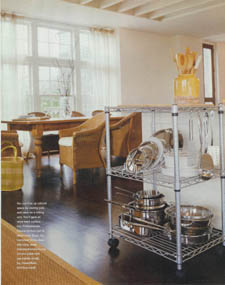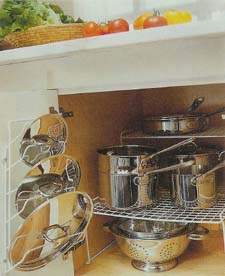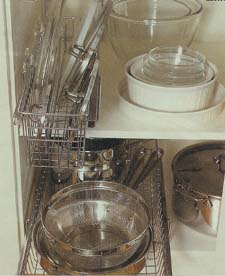![]()
Your Problem:
Crowded Kitchen Cupboards
Lucy Northrop, a 40-year-old mother of three, has no difficulty – despite her full-time job as a newspaper and education coordinator in Washington, Pennsylvania – keeping flawless track of a schedule jam-packed with orthodontist’s appointments and basketball practices. She can’t open her cupboards, however, without their contents clattering onto the floor. “It’s such a regular event,” she says, “that my kids don’t even come running in to check on me anymore.” In the two base cabinets in the small gallery kitchen of her 110-year-old house, pots, pans, and lids are jumbled together with bakeware, appliances, glass casseroles, and plastic containers. “Everything got mixed up,” she says, “when the upper cabinets became full and the drawers were too stuffed to hold anything else. So things started migrating.”
Lucy cooks as a necessity, not a pleasure, so organizing her cupboards hasn’t been a priority. “Some people cook to relax,” she says, “I don’t. It stresses me out. But I’ve realized it’s all the more reason to have an organized kitchen.”
SOLUTION #1: SORT
Pull things out one at a time and sort similar items into piles. Pots and pans in one pile, bakeware in a second, small appliances in another.
SOLUTION #2: PURGE
Cast a critical eye over each item as you sort. Discard anything that’s broken and can’t be repaired or is missing parts, like a pot without a handle or storage containers without lids. Eliminate duplication. If you have three frying pans of the same size, put the most worn one in the donation box, along with anything you haven’t used in more then a couple of years. (Lucy realized that she had never once used a plastic jell-O mold that was taking up valuable space.)
SOLUTION #3: STORE SMART
Keep things you use all the time close at hand. Keep things you use every now and then, like muffin tins and cookie sheets, in a less accessible cabinet. Move items you use only once a year, like holiday china and the roasting pan for the turkey, out of the kitchen altogether. In Lucy’s case, baking pans – remnant from her stay-at-home-mom days – were moved to a cabinet over the refrigerator, displacing Christmas china to a labeled box in the garage. Storage containers joined others in an upper cabinet, leaving the base cabinets to comfortably accommodate pots, pans, and casseroles.
QUICK TIPS
- If you’re replacing pots and pans, opt for metal-handled models. That way you can use them on the stove and in the oven (meaning you can get rid of a casserole or two). Almost anything you can bake in a casserole dish – from macaroni and cheese to fillet of sole – you can bake in a saucepan or a sauté pan. Any metal handled pot is safe up to 400 degrees.
- If you bake often, install space-saving vertical dividers in base cabinets to keep cookie sheets, muffin pans, and cooling racks upright.
- You can free up cabinet space by storing pots and pans on a rolling cart. You’ll gain an extra work surface, too.
 You can free up cabinet space by storing pots and pans on a rolling cart. You’ll gain an extra work surface, too.
You can free up cabinet space by storing pots and pans on a rolling cart. You’ll gain an extra work surface, too.
 Stacking wire shelves (three shown) can add efficient shelves where none exist.
Stacking wire shelves (three shown) can add efficient shelves where none exist.
 Bins mounted on gliders allow even easier access to pots, pans, and lids.
Bins mounted on gliders allow even easier access to pots, pans, and lids.
